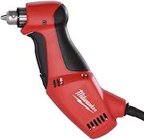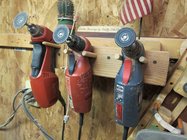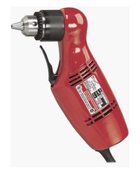-
April 2025 Turning Challenge: Turn an Egg! (click here for details) -
Congratulations to Kelly Shaw winner of the March 2025 Turning Challenge (click here for details) -
Congratulations to Ellen Starr for "Lotus Temple" being selected as Turning of the Week for 21 April, 2025 (click here for details) -
Welcome new registering member. Your username must be your real First and Last name (for example: John Doe). "Screen names" and "handles" are not allowed and your registration will be deleted if you don't use your real name. Also, do not use all caps nor all lower case.
You are using an out of date browser. It may not display this or other websites correctly.
You should upgrade or use an alternative browser.
You should upgrade or use an alternative browser.
Milwaukee Right Angle Drill for sanding
- Thread starter George Pagliarulo
- Start date
That style seems to be the tool of choice for a lot of people.I have a corded Milwaukee 0379-1 right angle drill that I have had for years. It has a 1/2” chuck, reverse, 0-750 rpm, the angle is 55°. It is also built like a tank at 3-1/2lbs. Weight aside, would this work for bowl sanding?
View attachment 57611
Dave Landers
Beta Tester
I use what I assume is probably a later version of that drill (0370-20). Built like a plastic tank 

Works pretty good. Had it 4 1/2 years, use it for nothing but sanding.
I did mess with the trigger so I could slow it down a bit (put a screw in the trigger as a stop). The paddle handle on yours would be easier to speed-control (extra finger or block of wood under it).

Works pretty good. Had it 4 1/2 years, use it for nothing but sanding.
I did mess with the trigger so I could slow it down a bit (put a screw in the trigger as a stop). The paddle handle on yours would be easier to speed-control (extra finger or block of wood under it).
Absolutely! These older Milwaukee and Sioux 55° angle drill are all I will use anymore. You're right that they are built like a tank.....because they are made for, and widely used in the construction industry. The old versions, like yours, work very well for on-lathe sanding. There is an updated version where the reverse/forward lever is now a switch, and the cord exit in in a better location for interior bowl work, but that's a minor consideration.I have a corded Milwaukee 0379-1 right angle drill that I have had for years. It has a 1/2” chuck, reverse, 0-750 rpm, the angle is 55°. It is also built like a tank at 3-1/2lbs. Weight aside, would this work for bowl sanding?
View attachment 57611
There are cheaper Chinese made "knock-offs" that are available, but I've found them to be made with cheaper plastic internal parts that don't hold up as well to the stress of continuous sanding that lathe turners often demand. (These days, I'm doing much less sanding than I used to do. I have eliminated exterior power sanding entirely and only use these drills for interior sanding.......consequently, I do not require the kind of performance from these sanders that I used to.....but, that's a whole 'nuther story for another time!)
In the photo, the one on the left is the newest version, and is the same one Dave Landers is using. It's shape isn't nearly as adaptable to interior sanding as the two older versions...... and it's also contracted through China by Milwaukee, but still of very durable components.
-o-

George, that is an older drill from the days when Sioux made them for Milwaukee. The newer model is the newer one that Milwaukee now makes for themselves. I also have one of them, and 3 of the old ones. I don't do production work any more, so they last a lot longer. They are drills first, but we use them as grinders, which is hard on the bearings. Eventually the bearings will go out, as do the brushes. For a lot longer life, I always sand at slow drill speeds, with the trigger never pulled down more than half way. I used to keep a piece of cork under the trigger to keep me from pressing all the way down. The abrasives cut better at the lower speeds. Also, no more than the weight of the drill for sanding pressure. If you are bogging your drill down, you are pushing way too hard. I did try one cheap drill, and the trigger mechanism broke within the first month. I also tried a battery powered one, and I would have needed 4 or so sets of batteries to keep sanding since I tend to do things in batches. The cord is not a problem.
robo hippy
robo hippy
Yes, I use them all the time...
A great tool for sanding bowls.
That “body style” is the best. I have several off brand of that style, and a Bauer/HF of the newer style. Both work but the older style is ergonomically better.
Tip: some use a speed lever limiter to set the speed. I use a router speed control (~18 at HF) to set speed, and a velcro cord strap to hold the lever down. I can hold the drill any way I want. As Robo said slow speed sanding, a few 100 rpm, and a light touch. If serious material removal is needed with 1st grit use a bit more speed and pressure, and use “spot/area removal”, stop the piece and sand just the bad area.
Tip: some use a speed lever limiter to set the speed. I use a router speed control (~18 at HF) to set speed, and a velcro cord strap to hold the lever down. I can hold the drill any way I want. As Robo said slow speed sanding, a few 100 rpm, and a light touch. If serious material removal is needed with 1st grit use a bit more speed and pressure, and use “spot/area removal”, stop the piece and sand just the bad area.

